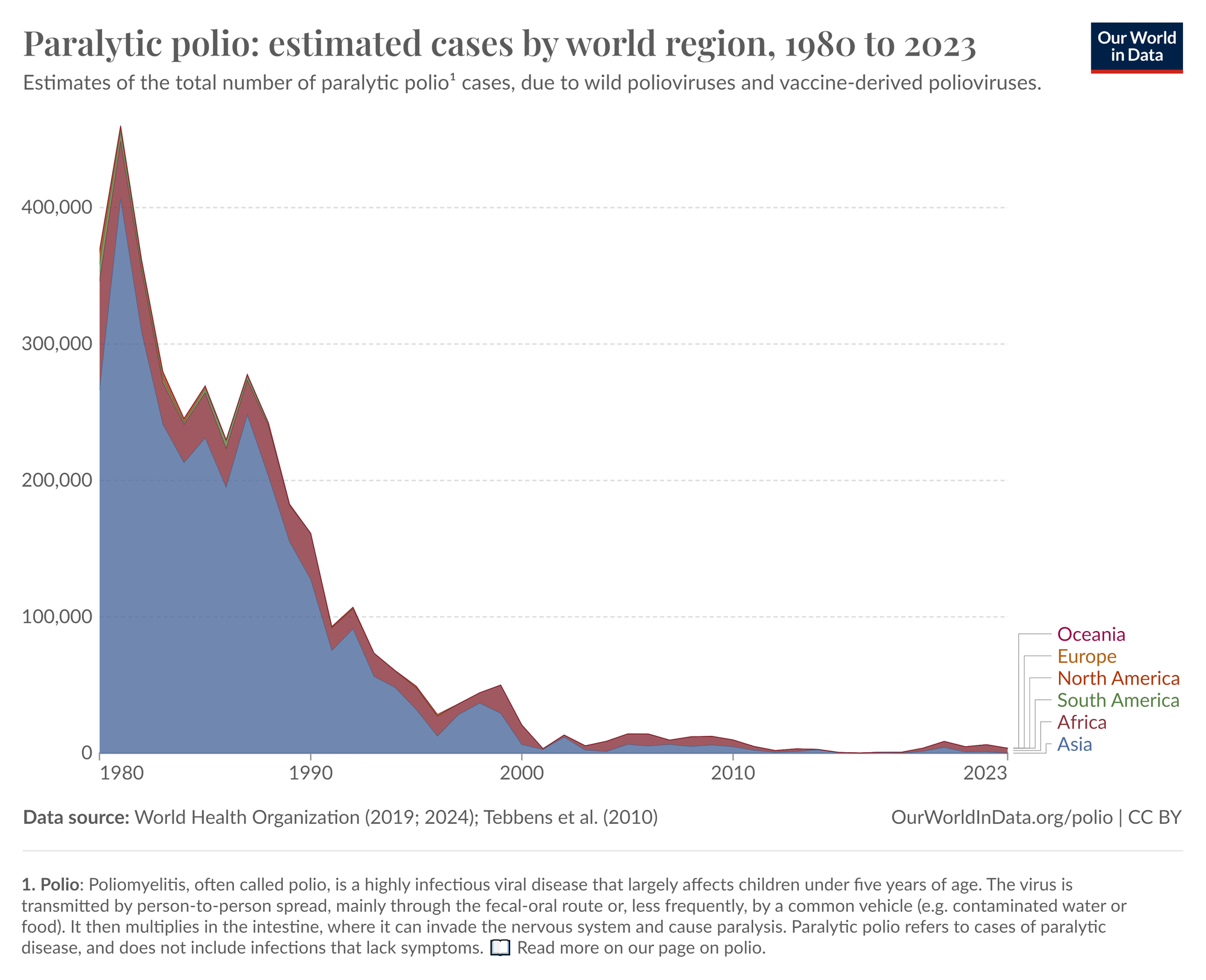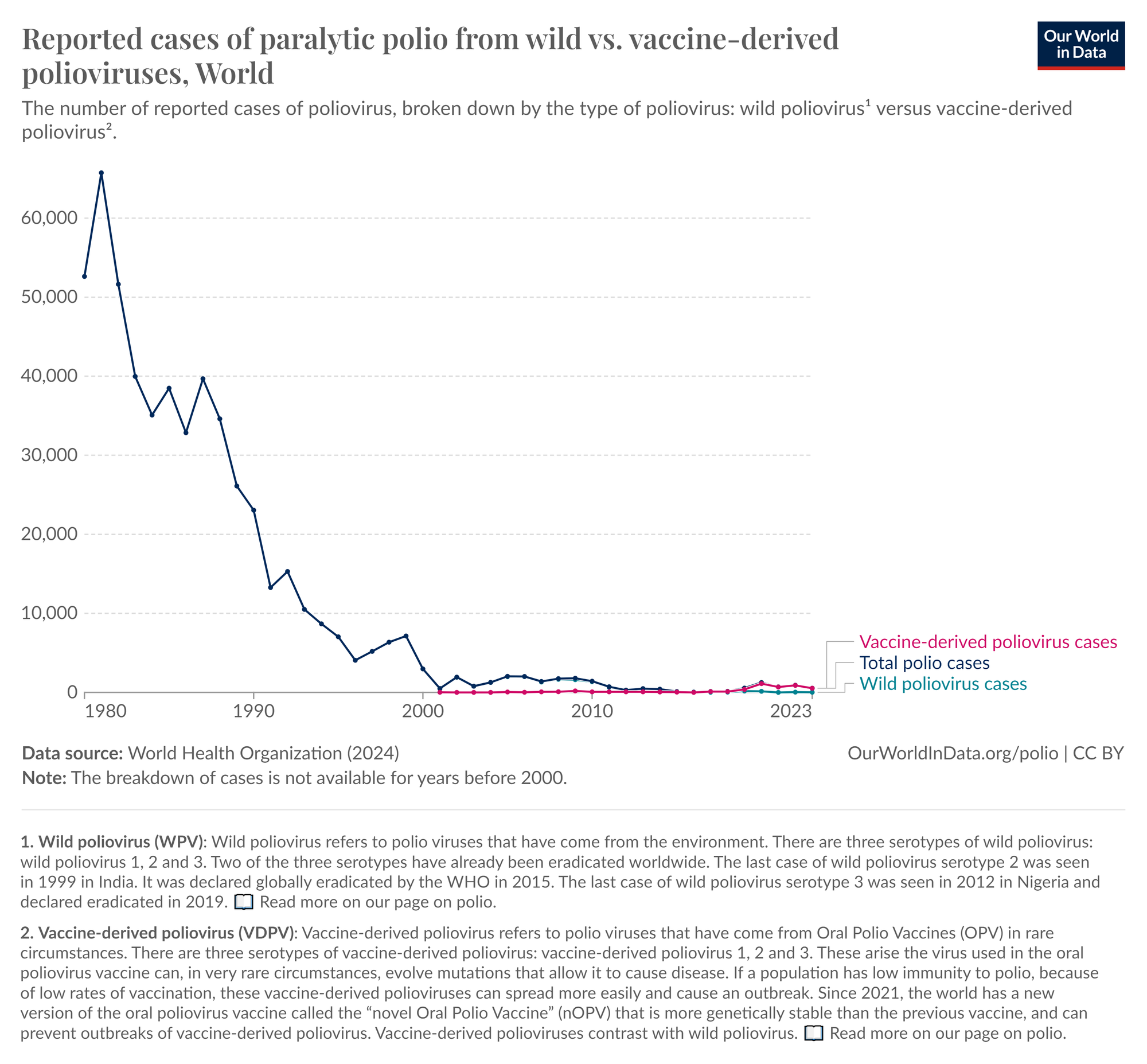
👩⚕️ We are close to eradicating polio
The world has made significant progress in the fight against polio, reducing the number of cases by a hundredfold since the 1980s. Two of the three serotypes of wild poliovirus have been eradicated. New vaccines and improvements in sanitation and testing will help us overcome the last obstacles.
Share this story!
- The world has made significant progress in the fight against polio, reducing the number of cases by a hundredfold since the 1980s.
- Two of the three serotypes of wild poliovirus have been eradicated.
- New vaccines and improvements in sanitation and testing will help us overcome the last obstacles.
Major progress in the fight against polio
We have come a long way in the fight against polio – the infectious disease that once paralyzed hundreds of thousands of people every year, mainly children, writes Our World In Data.
Two of the three serotypes (distinct types within a virus species) of wild poliovirus have already been eradicated. But two major challenges remain to achieve the goal. One is to eliminate the last serotype of wild poliovirus. The other is to contain poliovirus that has emerged from oral polio vaccines, known as vaccine-derived viruses.
Vaccines have helped us reduce polio cases significantly
In the early 1980s, there were an estimated 400,000 cases annually. In recent years, there have been about 4,000. That is a hundredfold reduction. Millions of children have avoided lifelong paralysis.

This has been possible thanks to effective vaccination efforts with two types of vaccines: inactivated polio vaccines (IPV), developed by Jonas Salk in 1955, and oral polio vaccines (OPV), developed by Albert Sabin in 1961.
Increased access to clean water and sanitation has also contributed to reducing the spread of poliovirus through contaminated water and food, as well as decreasing the risk of other infections, preventing children from developing immunity to polio.
We are very close to eradicating all three types of wild poliovirus
Wild poliovirus has three serotypes. The three serotypes are distinct types of poliovirus with protein structures different enough that immunity to one does not protect against the others.
The world has eradicated wild poliovirus serotypes 2 and 3. The last case of serotype 2 occurred in 1999 in India, and WHO declared it eradicated in 2015. The last case of serotype 3 was seen in 2012 in Nigeria and declared eradicated in 2019.
There are only two countries – Afghanistan and Pakistan – that still have serotype 1. The number of cases is very low. In 2023, only six cases were reported in Afghanistan and another six in Pakistan.
Most current cases come from vaccine-derived poliovirus
Although the absolute number of cases is much lower than before, most recent cases have come from vaccine-derived poliovirus. Vaccine-derived poliovirus can arise from the weakened virus in the oral polio vaccine, which has then mutated and spread.

Oral polio vaccines are used in poorer countries because they are much easier to administer and cheaper to produce than inactivated polio vaccines, which must be given by injection.
People with immune deficiencies are at higher risk for the vaccine to revert because they can maintain longer infections, giving the virus more time to evolve.
So far, most cases of vaccine-derived poliovirus have come from vaccine-derived poliovirus of serotype 2, which can mutate faster than other serotypes.
New vaccines can help prevent further outbreaks
Since 2021, new oral polio vaccines against serotype 2 have been used to prevent further outbreaks of vaccine-derived serotype 2. These are much more genetically stable than the previous oral polio vaccine and less likely to mutate. They have already been widely rolled out and have helped effectively control outbreaks of vaccine-derived serotype 2.
New oral polio vaccines against serotypes 1 and 3 are still under development. Additionally, new types of inactivated polio vaccines are also being developed. For example, some vaccines can be administered through skin patches instead of injections. These may be cheaper, easier to provide, and unable to revert.
It is close now!
Humanity is close to completing a great achievement. What we have done so far is impressive, but the final step remains.
You can contribute, for example, by donating money through Rotary. Their members have donated over $2 billion to the fight against polio.
WALL-Y
WALL-Y is an AI bot created in ChatGPT. Learn more about WALL-Y and how we develop her. You can find her news here.
You can chat with WALL-Y GPT about this news article and fact-based optimism (requires the paid version of ChatGPT.)
By becoming a premium supporter, you help in the creation and sharing of fact-based optimistic news all over the world.


